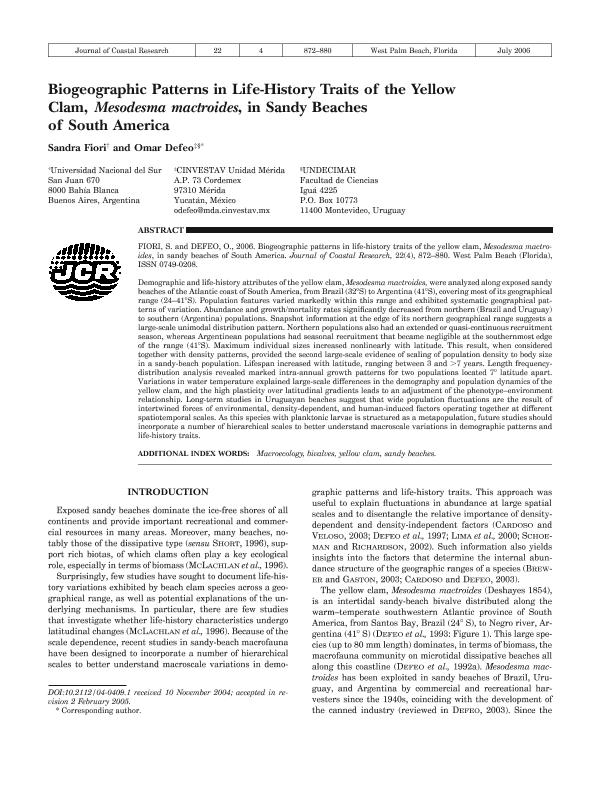Mostrar el registro sencillo del ítem
dc.contributor.author
Fiori, Sandra Marcela

dc.contributor.author
Defeo, Omar
dc.date.available
2017-06-23T17:48:48Z
dc.date.issued
2006-12
dc.identifier.citation
Fiori, Sandra Marcela; Defeo, Omar; Biogeographic Patterns in Life-History Traits of the Yellow Clam, Mesodesma mactroides, in Sandy Beaches of South America; Coastal Education & Research Foundation; Journal Of Coastal Research; 22; 4; 12-2006; 872-880
dc.identifier.issn
0749-0208
dc.identifier.uri
http://hdl.handle.net/11336/18744
dc.description.abstract
Demographic and life-history attributes of the yellow clam, Mesodesma mactroides, were analyzed along exposed sandy beaches of the Atlantic coast of South America, from Brazil (32ºS) to Argentina (41ºS), covering most of its geographical range (24?41ºS). Population features varied markedly within this range and exhibited systematic geographical patterns of variation. Abundance and growth/mortality rates significantly decreased from northern (Brazil and Uruguay) to southern (Argentina) populations. Snapshot information at the edge of its northern geographical range suggests a large-scale unimodal distribution pattern. Northern populations also had an extended or quasi-continuous recruitment season, whereas Argentinean populations had seasonal recruitment that became negligible at the southernmost edge of the range (41ºS). Maximum individual sizes increased nonlinearly with latitude. This result, when considered together with density patterns, provided the second large-scale evidence of scaling of population density to body size in a sandy-beach population. Lifespan increased with latitude, ranging between 3 and 7 years. Length frequency distribution analysis revealed marked intra-annual growth patterns for two populations located 7 grades latitude apart. Variations in water temperature explained large-scale differences in the demography and population dynamics of the yellow clam, and the high plasticity over latitudinal gradients leads to an adjustment of the phenotype environment relationship. Long-term studies in Uruguayan beaches suggest that wide population fluctuations are the result of intertwined forces of environmental, density-dependent, and human-induced factors operating together at different spatiotemporal scales. As this species with planktonic larvae is structured as a metapopulation, future studies should incorporate a number of hierarchical scales to better understand macroscale variations in demographic patterns and life-history traits
dc.format
application/pdf
dc.language.iso
eng
dc.publisher
Coastal Education & Research Foundation

dc.rights
info:eu-repo/semantics/openAccess
dc.rights.uri
https://creativecommons.org/licenses/by-nc-sa/2.5/ar/
dc.subject
Yellow Clam
dc.subject
Population Dynamics
dc.subject
Sandy Beaches
dc.subject
South Atlantic Coast
dc.subject.classification
Ecología

dc.subject.classification
Ciencias Biológicas

dc.subject.classification
CIENCIAS NATURALES Y EXACTAS

dc.title
Biogeographic Patterns in Life-History Traits of the Yellow Clam, Mesodesma mactroides, in Sandy Beaches of South America
dc.type
info:eu-repo/semantics/article
dc.type
info:ar-repo/semantics/artículo
dc.type
info:eu-repo/semantics/publishedVersion
dc.date.updated
2017-05-17T13:48:19Z
dc.journal.volume
22
dc.journal.number
4
dc.journal.pagination
872-880
dc.journal.pais
Estados Unidos

dc.journal.ciudad
West Palm Beach
dc.description.fil
Fil: Fiori, Sandra Marcela. Universidad Nacional del Sur. Departamento de Biología; Argentina. Consejo Nacional de Investigaciones Científicas y Técnicas. Centro Científico Tecnológico Conicet - Bahía Blanca. Instituto Argentino de Oceanografía. Universidad Nacional del Sur. Instituto Argentino de Oceanografía; Argentina
dc.description.fil
Fil: Defeo, Omar. Instituto Politécnico Nacional Unidad Merida; México. UNDECIMAR Facultad de Ciencias Igua; Uruguay
dc.journal.title
Journal Of Coastal Research

dc.relation.alternativeid
info:eu-repo/semantics/altIdentifier/url/http://www.jcronline.org/doi/abs/10.2112/04-0409.1?code=cerf-site
dc.relation.alternativeid
info:eu-repo/semantics/altIdentifier/doi/http://dx.doi.org/10.2112/04-0409.1
Archivos asociados
